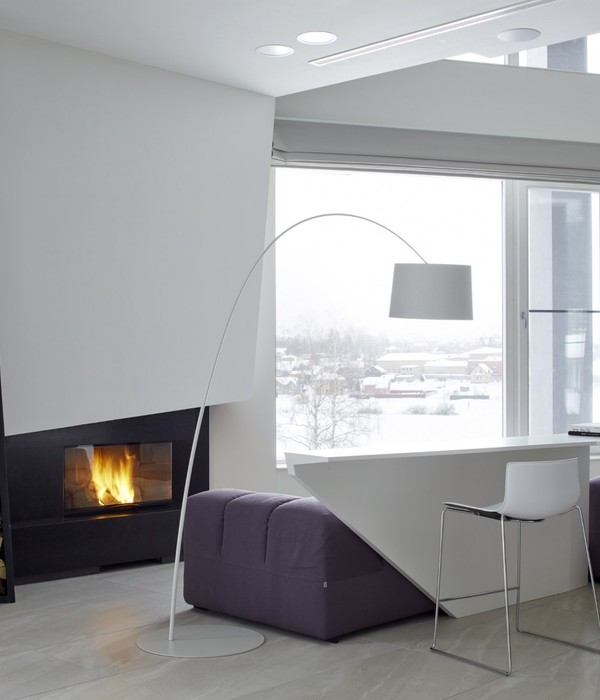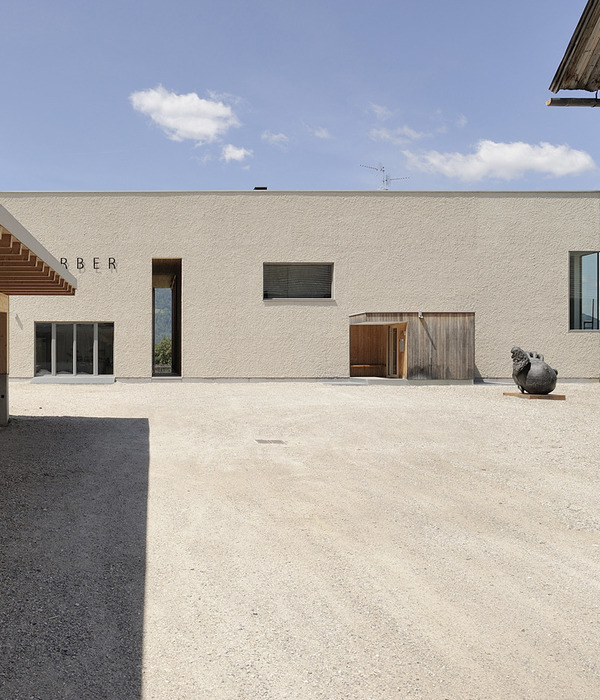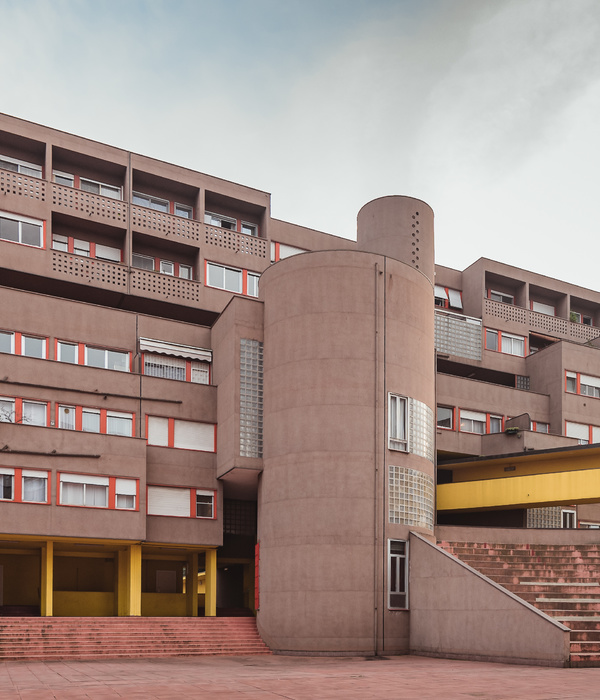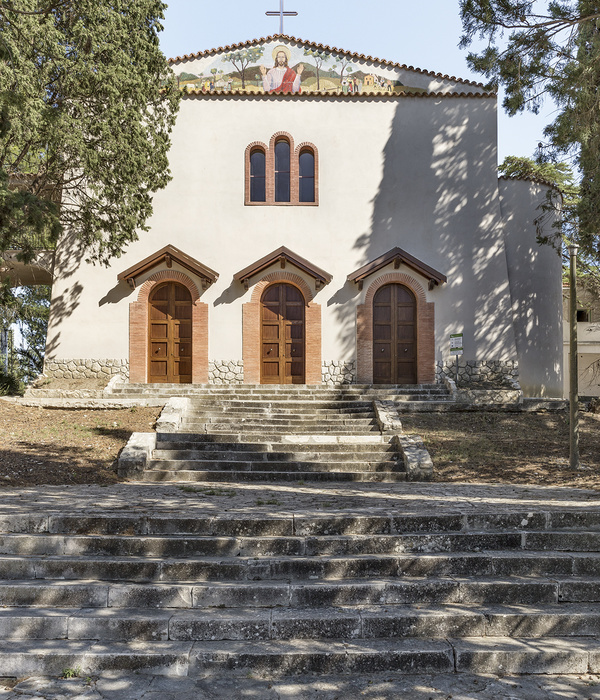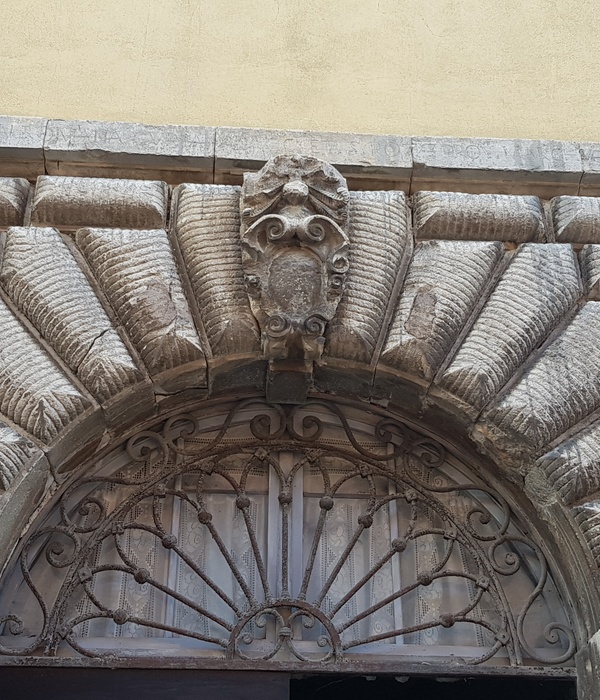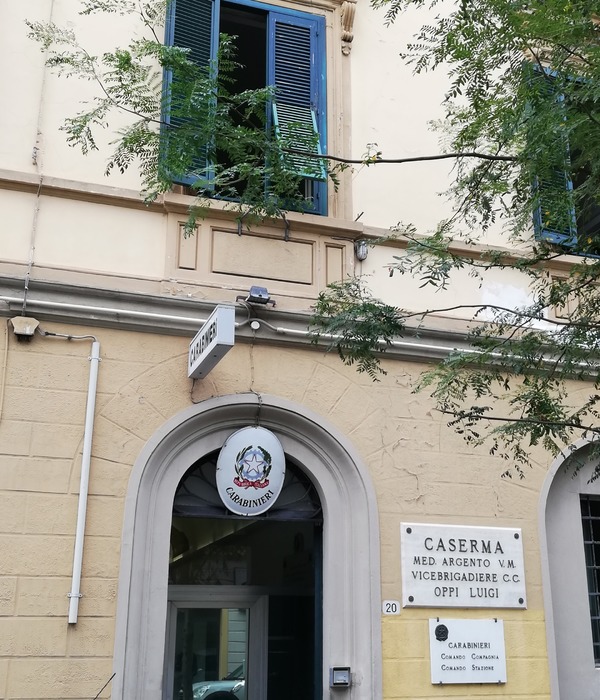OFFICE真相专辑 NO.37 — 叙向llLab.
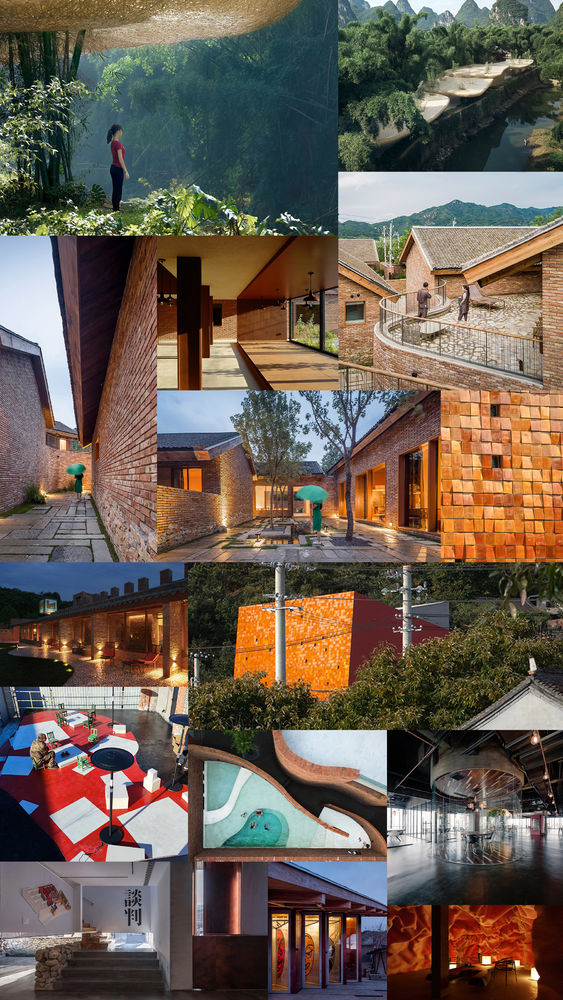
_________ 乡村复兴与活化 Rural Rejuvenation And Revitalization
Q: 您认为的乡村复兴与活化的关键点是什么?如何避免徒有其表的“乡村改造”,真正地建立人与乡村空间的联结,甚至吸引人回到乡村? What are the critical factors for the revival and revitalization of rural areas? How to prevent mere superficial “rural transformations” and genuinely establish a connection between people and rural spaces, even inviting individuals to return to the countryside?
刘涵晓:北沟村的项目我们做了8年,村书记从当兵回到村子以后就一直在做这个事情。现在听说他儿子准备回村去继承他们,继续发展村落。经过十几年的时间,这种回潮现在慢慢开始出现了。建设方面我觉得应该告一段落了,下面应该是村子和村民去酝酿和成长的时间。这个体系已经形成了,跟之前完全山旮旯的样子不一样了。现在有意思的一点是,这种乡村建设,如果不是完整地看,而只是从其中的一个片段去了解图像性的内容,它始终看起来都是一个假的东西。这有点难以去描述,或者可以说,如果不跟我们一样经历这个过程,包括中间的种种付出,你始终没有办法理解乡村振兴的过程,有可能会很片面。
▼北京三卅村中之村,生长的院落,San Sa Village, The growing courtyards create a village within the village ©Fernando Guerra I FG+SG 点击这里查看更多,Click HERE for details
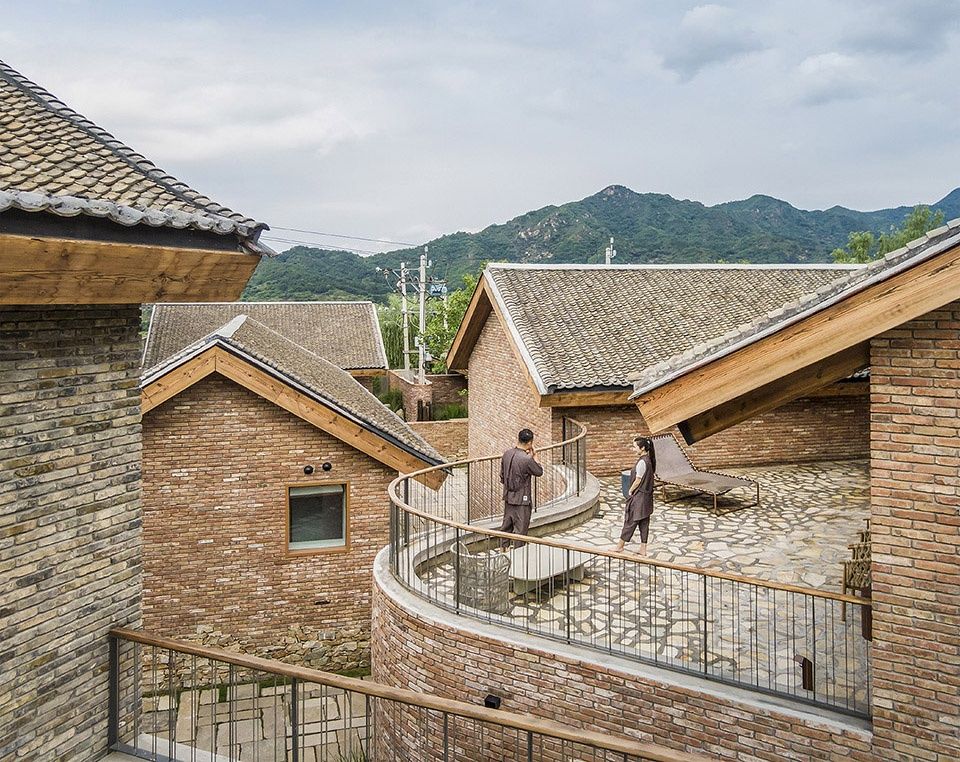
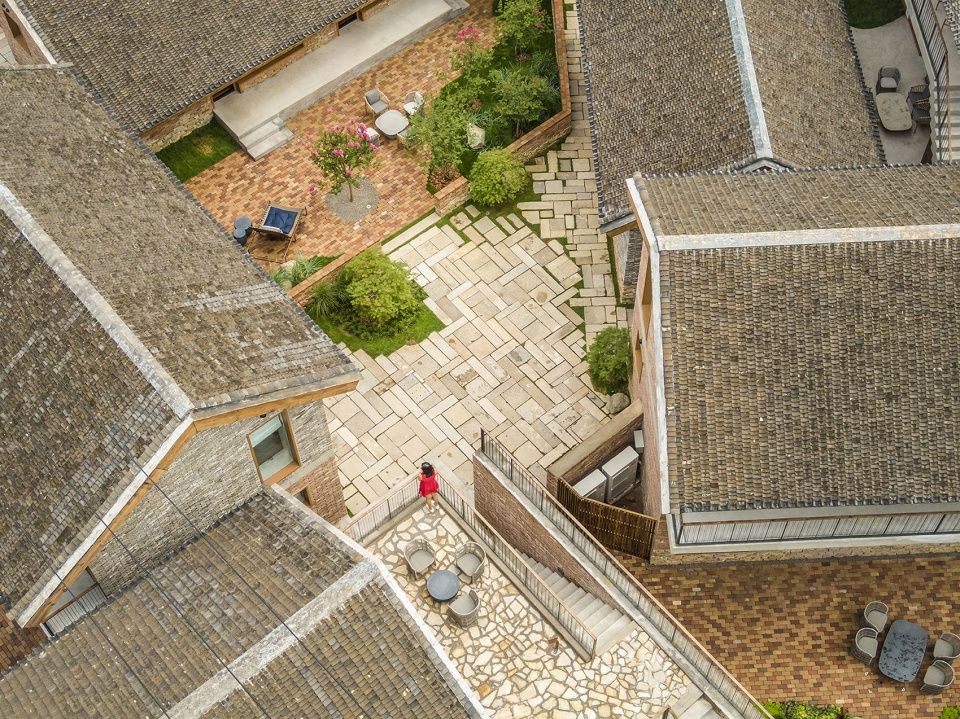
我们的项目不是规划出来的,而是尝试出来的。在这个过程当中,我们会跟所有的业主讨论我们要做什么。不是说建筑要长成什么样,而是说它在这个地方的意义是什么?如果到半年以后它对于当地来说没有意义了,我们就不做了,我们有胆量把之前的付出全部断掉。
这么多年下来,我们的甲方也非常信任我们。我们在方案进行当中就会感觉到什么是可行和不可行的,思想也会慢慢沉淀到一个冷静的程度,甚至是到一个“扫兴“的程度。比如做完一个方案之后,如果出现了一个让你感到明确不合适的状况,就意味着有些事情要重做了。如果客观事实让我们做出了一个很理性化,但是依然很有冲劲的方案的时候,我们就会用这个方法去落实。
▼北京瓦美术馆,WAAAM,Beijing © 存在建筑-建筑摄影
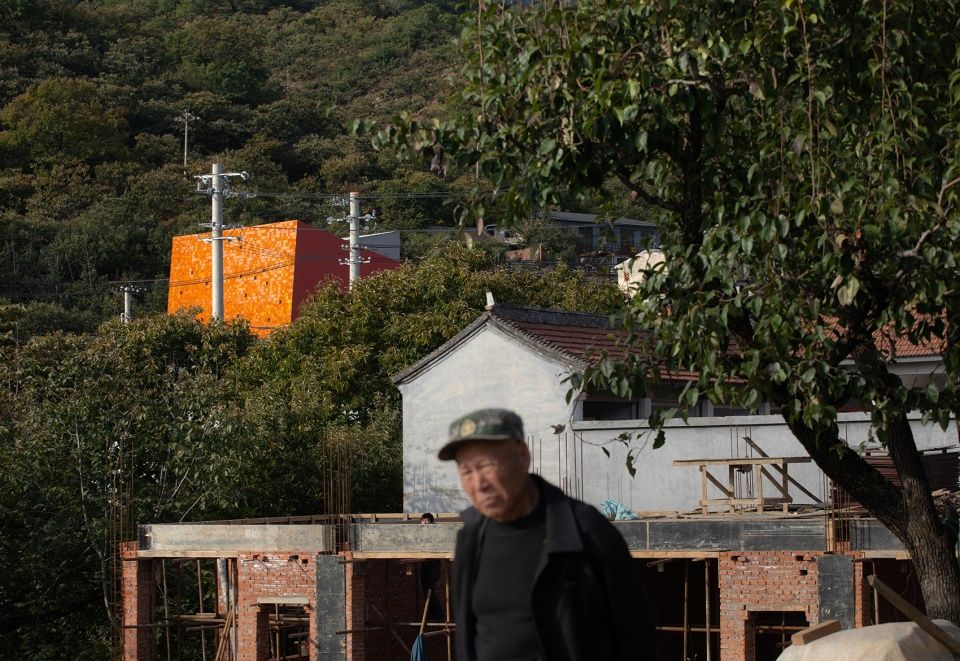
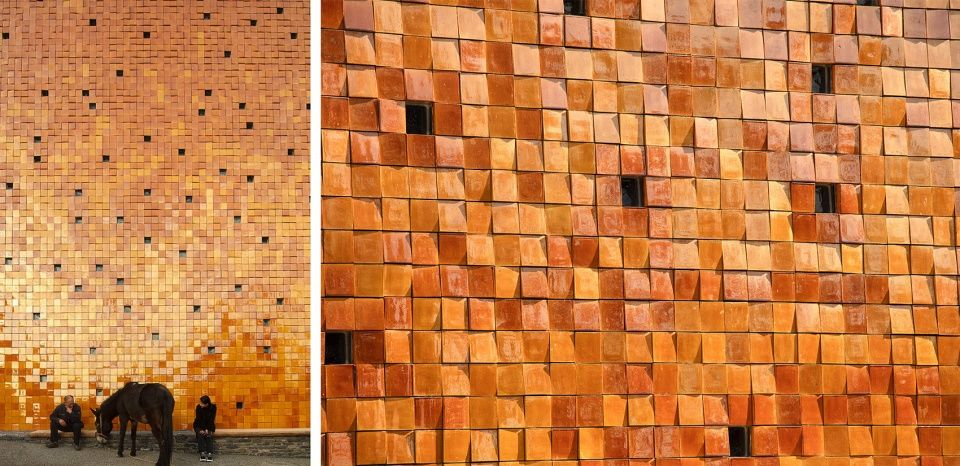
Liu Hanxiao: We have been engaged in the Beigou Village project for 8 years. In terms of construction, I believe it’s time to draw it to an end, allowing the village and its residents another period for contemplation and growth.
Our projects are not meticulously planned; they emerge through experimentation. Throughout this process, we engage in discussions with all stakeholders about our objectives. It’s not about prescribing the physical appearance of the architecture but rather understanding its significance in that specific context. If, after six months, it would lose meaning for the local community, we would be bold enough to give up our previous efforts.
During the design development, we can discern what is feasible and what is not. Our thoughts gradually settle into a calm state, perhaps even to a point of discouragement. If objective facts lead us to a rational yet impactful solution, we implement it using this method.
▼长城脚下的乡情驿站,A Nostalgic Space Hotpot Restaurant, Beer Garden and Event Space,Mutianyu Great Wall, Beijing 点击这里查看更多,Click HERE for details
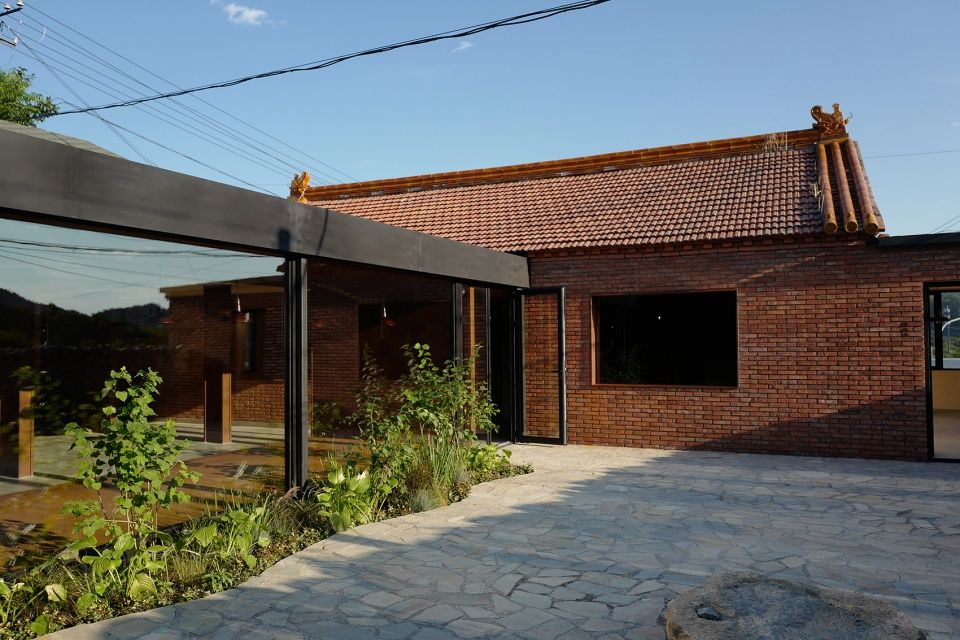
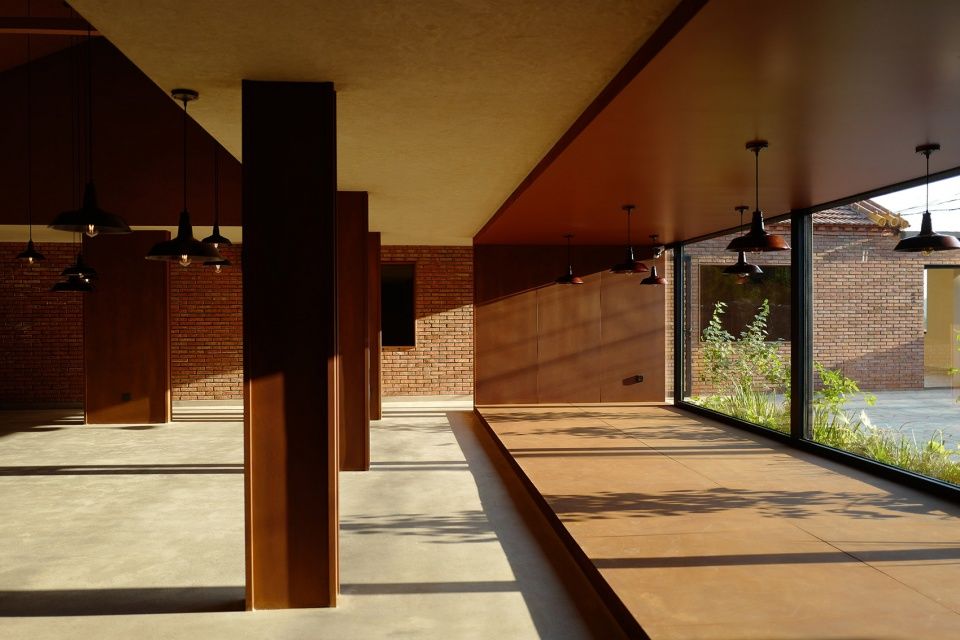
刘涵晓:在中国这样的环境之下,这种有意思的、有生命力的空间在不同的城市和文化背景下都会不太一样。有些事情要重复去做,有些事情要用不同的极端的方法做,这不仅需要你去做足够多的课题研究,还要研究社会。
说到乡村建设,我们的参照和意向都是来自于南方乡村,我们通过南方乡村的学习,开始了北沟乡村的建设。因为当时在我们的有限知识范围之内北方没有什么乡村可以参考。在北沟进行了长时间的实践之后,现在发生的事情是南方乡村开始从北沟的项目中提炼它的运营逻辑和知识,甚至还有研究型的团队专门过去考察。这件事情对于我们来说非常奇妙。
我们现在正在做的一个南方乡村,西南乡村的振兴项目,就来自于对于北沟的内容的提炼。这也说明我们之前对很多东西的预判是不成立的。我觉得之所以在乡村建设上做成的项目比较少,也是因为我们曾经参考的都是一些过于教条主义的东西。其实可以更加自发和零散一点,去真正感受具体的地方就可以。在尝试的过程当中,不要以既定目的为标准,而要以过程中的体验为标准,这样可能才不会冒犯到这个村子,不是为了做完这件事情而已。在一个温度和湿度都不一样的环境中,我们等于又要去重新尝试和学习,但整体的观念是没有变的,那就是我们永远不会只是做一个建筑,或者一个漂亮的东西,它永远是跟当地的百姓相连的。
Liu Hanxiao: In environments like China, the charm and vitality of spaces can manifest differently across diverse cities and cultural settings. Some aspects call for repetition, while others necessitate innovative and extreme approaches. Achieving these demands not only require extensive research across various domains but also a profound understanding of societal dynamics.
When it comes to rural development, our inspiration and aspirations stem from southern villages. By immersing ourselves in the study of these villages, we initiated the construction of Beigou Village. Following an extensive period of practical engagement in Beigou, a noteworthy trend is emerging – southern villages are distilling operational insights and knowledge from the projects in Beigou. There are even dedicated research teams specifically investigating here. This evolving dynamic is genuinely intriguing for us.
One of our ongoing projects involves the revitalization of a village in the southwest, born from the distilled content of Beigou. It’s an experience that can be more spontaneous and diverse, allowing us to authentically connect with a specific locale. Throughout the experimental process, the benchmark isn’t predetermined goals but the experiences garnered along the way. This ensures that our endeavors go beyond task completion, emphasizing a genuine respect for the uniqueness of each village. In an environment with varying temperatures and humidity, it’s akin to embarking on a renewed phase of experimentation and learning. Yet, the core principle remains steadfast – our creations will never be mere structures or aesthetically pleasing objects; they will always be intricately linked with the local community.
▼北沟新主义 – 实验性乡村演变舞台,beigou Comptoir – Ambeigouity – In transformation
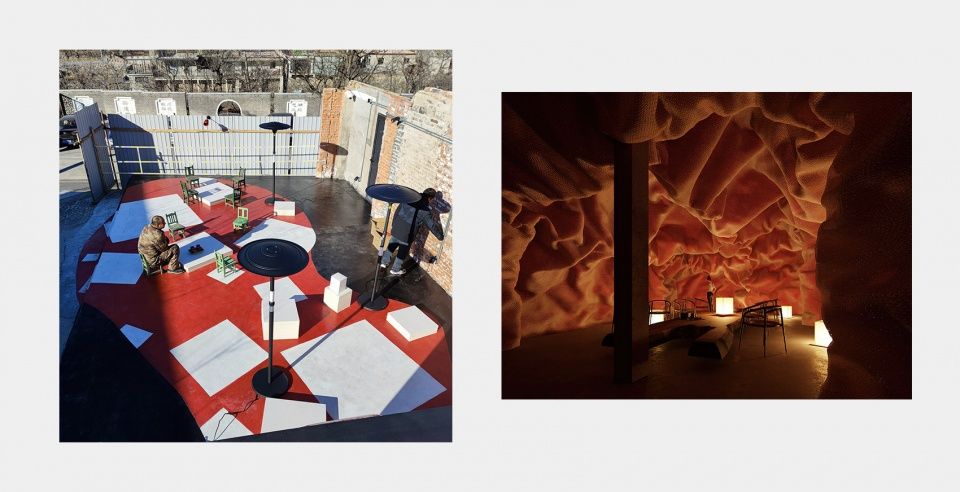
▼团队成员在项目场地工作时的照片,Photos of team members working on the project site
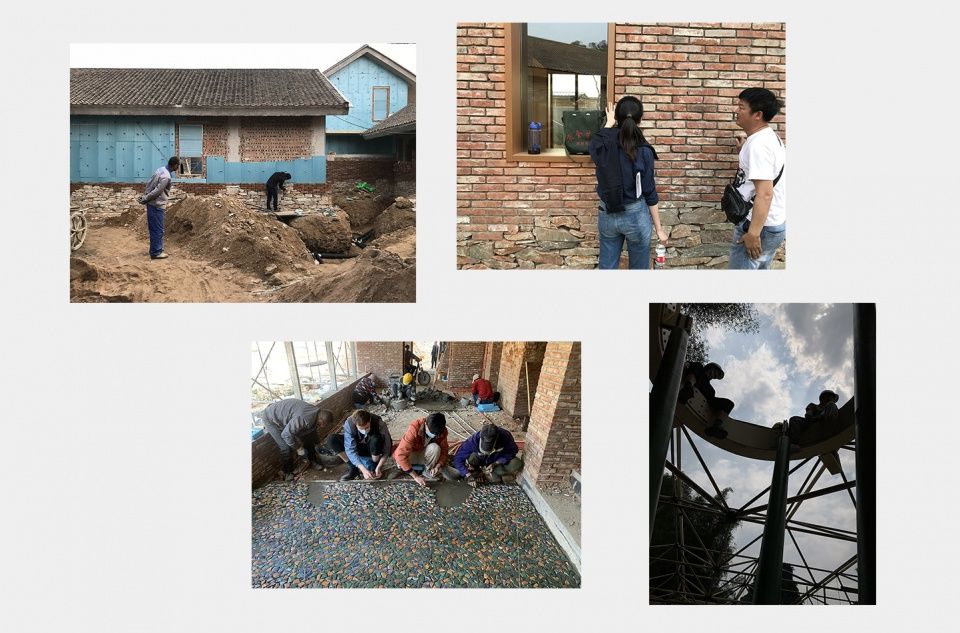
_________ 从乡村过渡到城市 From the countryside to the city
刘涵晓:北京的项目,现在已经从乡村过渡到和城市之间的连接处。顺义的钱粮市集和三八闹市探究的是社区,简单地说就是希望周边的居民提供一个回家路上的歇脚地,还有下楼散步和上班之前吃早饭的地儿。当时讨论的时候,就觉得现在所有为人服务的、能让人快乐的事情都变得非常粗野。所以这两个项目的主旨是希望能够让做食品、做小吃的这部分居民体验到专心钻研的快乐,同时营造街坊邻居生活的体验。
这两个项目的招商方向非常淳朴,它不是要去塑造一个看起来很漂亮的地方,而是把美容美发、早餐面包店,还有夜里开到两三点的烤串喝酒的地方全都放在广场里,以此给周围带来各种各样的生活。我觉得甲方的这种初衷和魄力非常让人敬佩,也让我们非常有兴趣去继续研究,但是这在目前的社会环境下并不容易实现。每一件事都涉及到对于现下状况的突破,而且这些突破都是跟社会有关的。我们在重新思考,并且尝试去打破它原有的逻辑。甲方给予了我们很大的信任,我们一起研究了每一个新的课题。在这个过程中,我发现往往是那种“一无所知”的背景能够让你突破一些既定的规矩。当然这要花费很大的功夫,我们其实也心惊胆战的。但是可以有这样的机会让你不停地试探做事情的新的方法,还是很有意思的。而且对年轻人来说,这样的实践对于他们的成长,以及提高他们对于这个行业的希望起到了很重要的作用。
Liu Hanxiao: The projects in Beijing have evolved from rural endeavors to connections between rural and urban spaces. The kommon market in Shunyi and 38 Shoe Factory delve into community dynamics, essentially aiming to provide a resting place for nearby residents on their way home. It also serves as a space for a leisurely stroll and breakfast before heading to work. During the discussions at that time, there was a realization that all services and activities aimed at bringing joy had become somewhat instinctive. Therefore, the core objective of these two projects is to allow residents involved in food and snack business to experience the joy of meticulous preparation of their meals while simultaneously creating a neighborhood life experience for the community.
▼位于北京顺义的钱粮市集与三八闹市模型,models of the kommon market and 38 Shoe Factory in Shunyi, Beijing
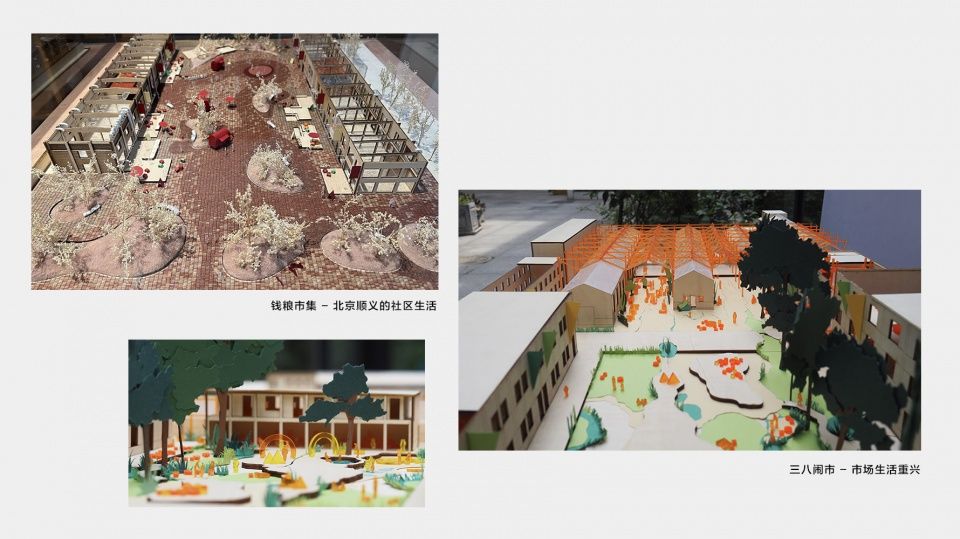
▼社戏,北京慕田峪长城脚下的一场乡村建设彩排,Village Opera,A Rehearsal of Rural Construction at Mutianyu Great Wall, Beijing © Jin Weiqi
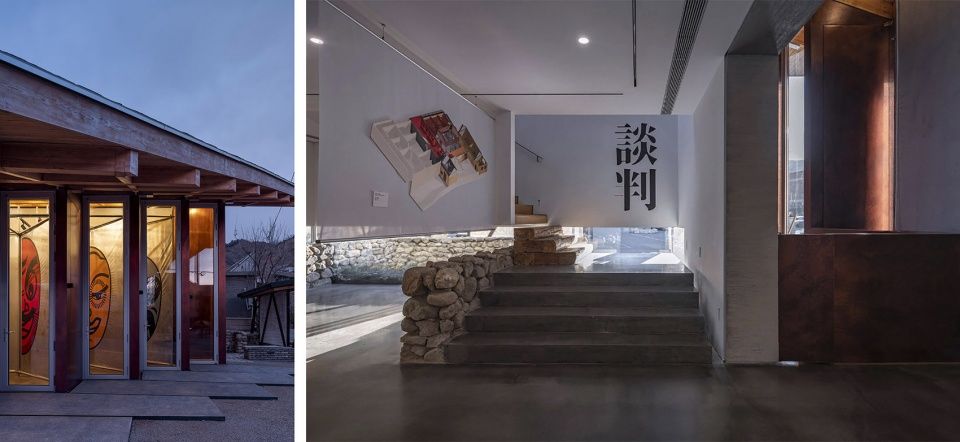
Luis Ricardo:能在北京乡村遇上这么好的客户让我们很高兴。对我们来说重要的是为乡村环境引入某种带有突破性的品质。另一方面,城市也需要农业方面的知识,特别是现在,除了消极的部分外,疫情也引发了人们对于城市肌理与城市需求的思考。很多人都希望能够在自己的家中拥有一个阳台或一小块绿色空间。有趣是的,我们发现全世界都开始意识到我们的城市需要更多的绿化。因此,如今我们更应该去了解,从如何对待植物,到如何创造一个菜园,再到如何与自然保持平衡。我们在农村和城市之间来回跳动,这两之间的相互影响非常深远。我们必须非常聪明,不被农村规划的潮流所迷惑。我们也必须真正认识到,有时候可持续发展是建立在改变与修复上的,而不总是在于为这些地方引入新的系统或材料。
Luis Ricardo: This is why we are really happy to have really good clients in the countryside. This is really important for us to bring this quality that is notso accessible to the rural environment. On the other hand, the urban side needs knowledge from agriculture as well, especially nowadays, I think besides all the bad things, the COVID also brings some awareness in terms of the urban fabric and urban needs? A lot of people like to have a balcony or some green space at their homes. This is interesting because I think the world tends to get aware that we need more greenery in the city. We need to know how to deal with plant, how to create a vegetable garden, and how to make the balance with the nature. We bounce between rural and urban influence each other a lot. We have to be really wise in not falling in tricks of the trend of planning the rural. We have to be really aware that sometimes sustainability is about changing and repairing, not always about new systems and materials.
▼北京慕田峪长城脚下的瓦厂改造,The Brickyard Retreat Renovation at Mutianyu Great Wall, Beijing © 存在建筑-建筑摄影
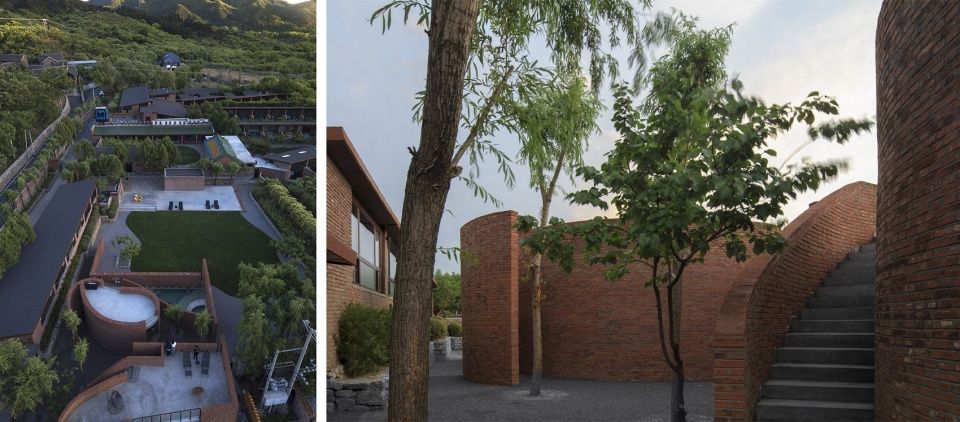
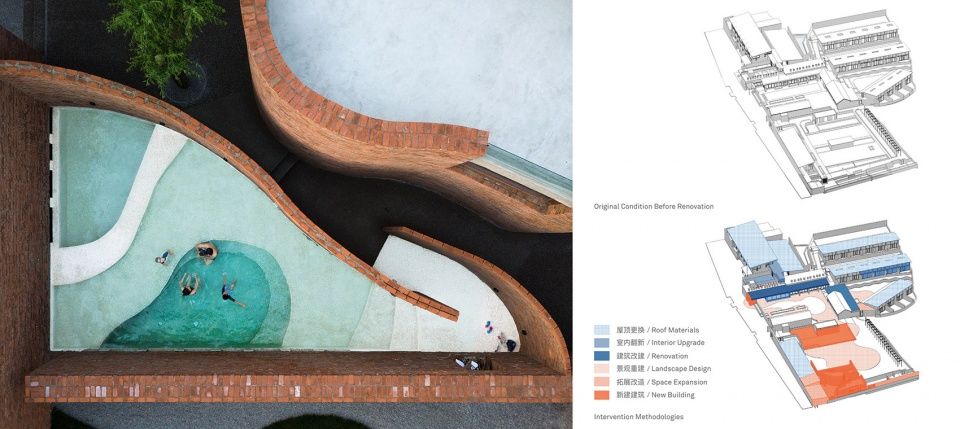
_________ 对传统文化与材料的诠释 Interpretation Of Traditional Culture And Materials
Q: 事务所通常如何挖掘和提取项目的本土化特征?在材料的使用上有何偏好?您如何看待施工、工艺制造和落地性在整个设计环节中的重要性? How do you usually unearth and incorporate local characteristics of the projects? Do you have specific material preferences? And, in your view, how crucial are construction, craftsmanship, and practical implementation throughout the entire design process?
刘涵晓:桂林阳朔印象刘三姐园区的设计是一个非常具有感觉性的过程。我直接提出了一些发自内心的方法,那就是对于这个项目,我认为没有任何材料可以取代竹子。在整体环境下,无论是竹丛形成的拱形通廊,还是随风摇摆的像是敲鼓一样的声音,它们都来自于竹子。所以我们把竹棚下面的空间变成了能够体验文化和演出的长廊,它的形态是通过周边的山水自然勾勒出来的。我们当时对于竹子的认知几乎是零,我们根本不懂什么竹子适合生长,什么竹子适合编织,或者是做结构,所以我们开始了很“不自信“的研究,从竹篮和竹灯的编织方法开始去了解,竹篾可以实现什么样的弧度和厚度,以及人手应该如何操作。从设计到研究材料再到制作,都是我们自己的团队经过一步步研究和讨论而实现的。此外还有施工过程的控制,包括工地控场等等。我们在施工期间遇到了洪水,几乎淹没了整个工地。我们的同事冲到现场,把所有浮动的东西都绑在地上,经历了一个比较“灾难性”的时刻。
Liu Hanxiao: The design process for Canopy and Pavilions, Impression Sanjie Liu Park was a deeply intuitive journey for me. I proposed some heartfelt approaches, emphasizing that, for this project, I believed no material could replace bamboo. Whether it’s the arched corridors formed by bamboo groves or the drum-like sounds swaying with the wind in the overall environment, they all originate from bamboo. Thus, we transformed the space beneath the bamboo pergola into a corridor for experiencing culture and performances, its form shaped by the surrounding natural landscape.
At that time, our understanding of bamboo was almost zero. We had no idea about which bamboo was suitable for growth, weaving, or structural purposes. So, we embarked on a rather “unconfident” research journey, starting with understanding the weaving methods of bamboo baskets and lanterns. We explored what curvature and thickness could be achieved with bamboo strips and how people should manipulate them. From design to material research and then to production, our team underwent a step-by-step study and discussion, accomplishing it independently.
▼刘三姐园区竹林亭台楼阁 – 竹之形编织自然情境之趣,Bamboo Bamboo, Canopy and Pavilions, Impression Sanjie Liu ©存在建筑 点击这里查看更多,Click HERE for details
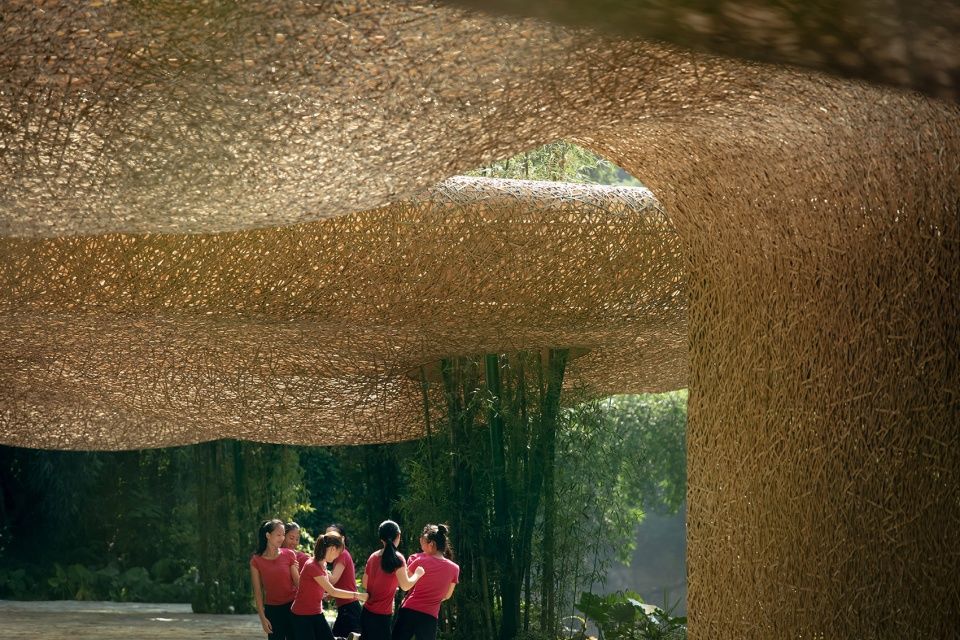
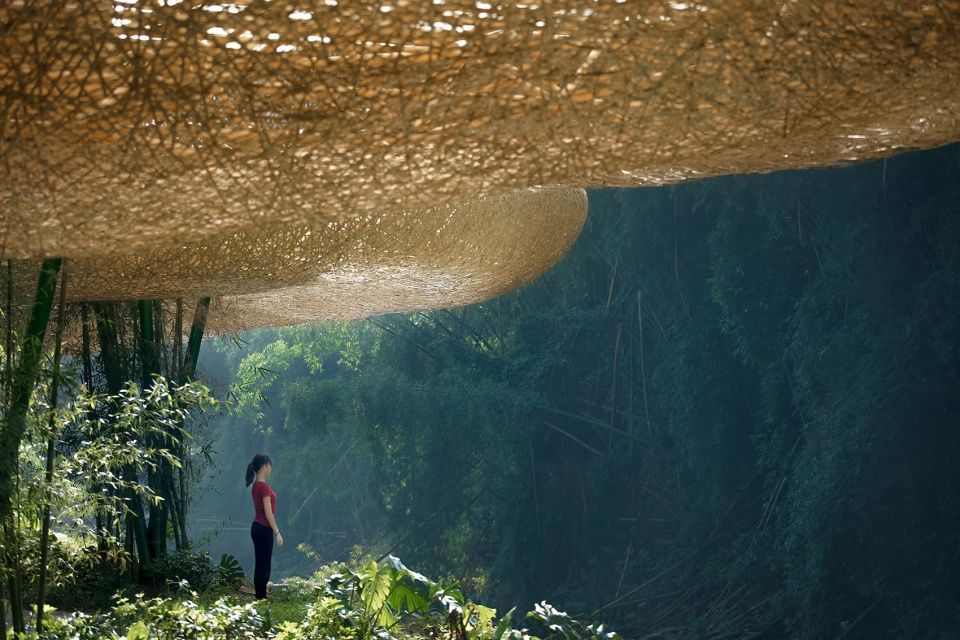
在材料和细节方面,我们偏重于用手去做东西,或者说比较笨拙的去做,对自己的感受比较信任,而不是把电脑数据直接提交给一些厂家去让他们实现。很多事情都是在你亲自去做了之后,别人才愿意陪伴你一起实践。我们的传统感觉,往往没有办法真正体现在一个建筑中。所以我们对于材料和尺度的把握,也都来自于真实的接触,以及微观的把握或是推敲。
▼自然生长的编织结构,naturally growing interweaved bamboo stripes ©存在建筑
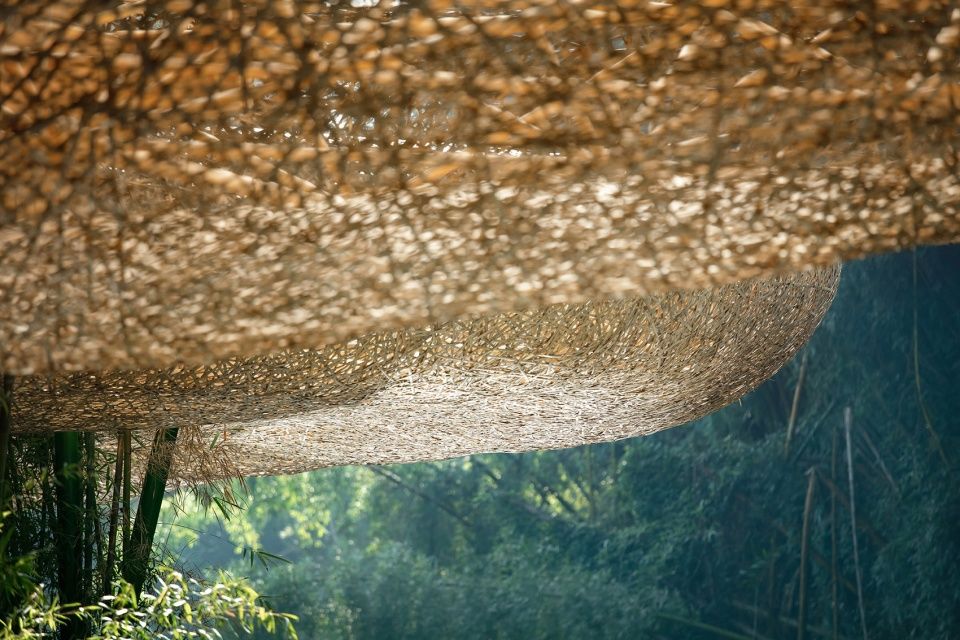
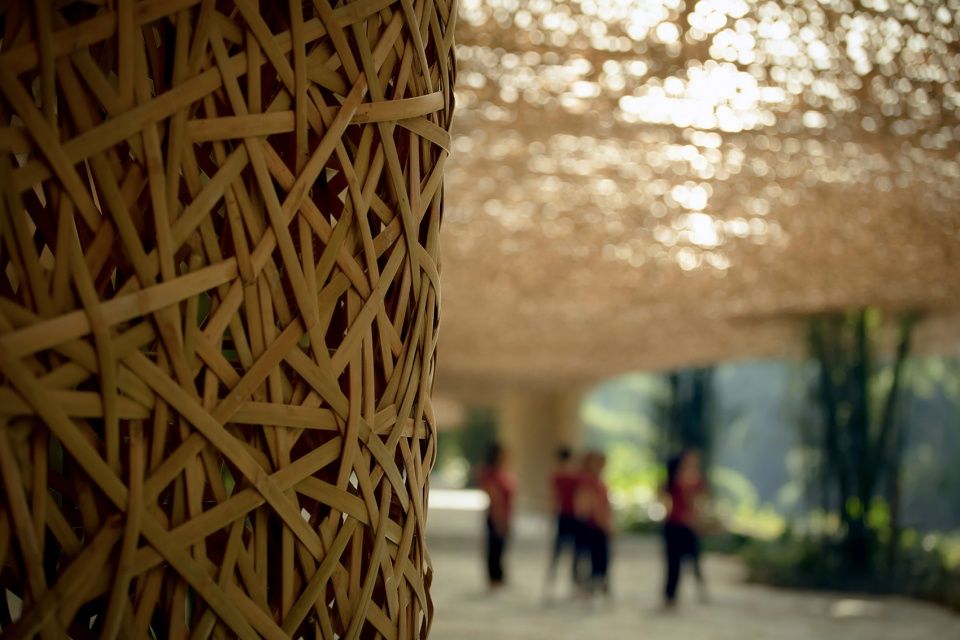
▼竹灯结构分析,structural analysis of the lantern ©llLab.

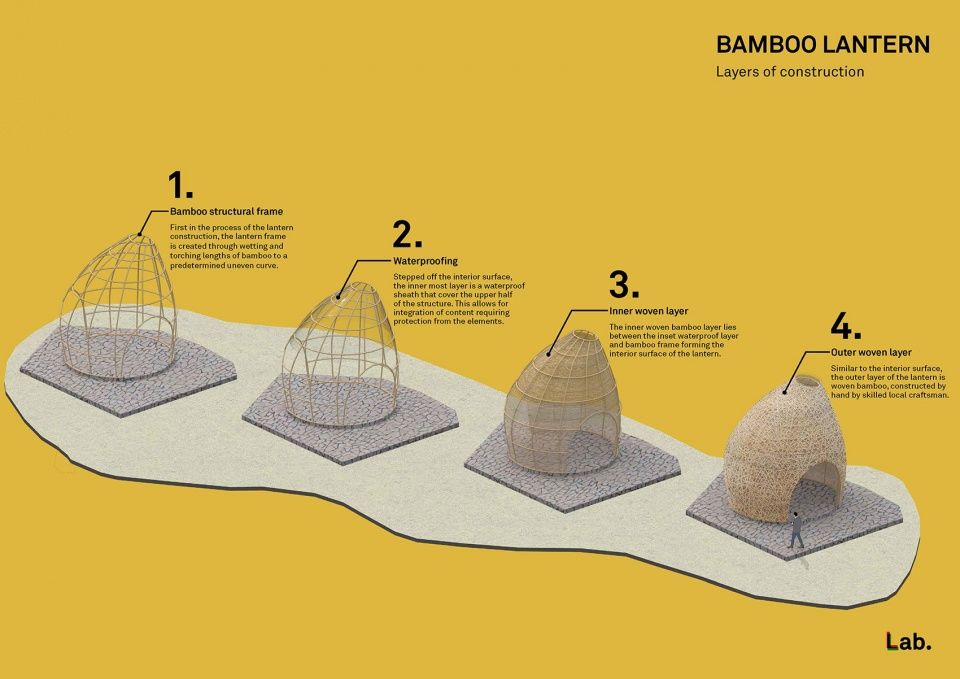
Q: 在商业项目中,llLab.的工作思路和方法有哪些不同于公共和文化项目的特别之处? In commercial projects, are there any different approaches that llLab. applied compare to the public and cultural projects?
Luis Ricardo:我们并不会区别对待商业或私人项目的设计,而是将我们所掌握的知识从一种类型的建筑活用到另一种类型当中。当我们做文化项目的时候,我们主要考虑的是如何平衡设计想法与公众的需求,试图去理解公众想要什么。在私人项目中,我们则需要更多地去了解客户想要什么。但如果你深入思考一下,就会发现其实无论在哪种情况下,都是去了解“人”的需求。所以,我们为什么要去改变设计方法呢?但有趣的是,我们发现在公共项目中,我们可能更有发挥的自由。我们会在这些项目中创造更多的社交空间,这在私人领域是非常困难的。我们也在试图引导私人客户产生这种意识。
Luis Ricardo: We don’t take a special approach for a commercial or for a private project, but what we do for sure is like we bring the knowledge from one to each other. When we make a cultural project, we learn how to balance ideas with the public and try to understand what the public want. In the private one we need to understand more what the clients want. But if you think deep like to the basis, both are for people, right? So, in the end, it’s the same public. So, why we should change the approach? In the meantime, it is interesting that in a public project we feel more freedom. We create more space to social engagement somehow is not possible in private ones. We try to bring this awareness to the private clients.
▼llLab.部分建成与进行中的商业项目,Partially completed and ongoing commercial projects of llLab.

刘涵晓:我一直认为我们在商业项目方面并不擅长,有时候大家也会开玩笑地自嘲。我们与老凤祥和Hypoport的合作实际上已经在一定程度上实现了突破。这些项目的最初目的其实并不是商业,所以才允许我们能够以一种不容易形象化的方式去生产内容,就算之后是商业化的,也似乎更加有趣味。
上海老凤祥总部的前身是工艺美术大楼,它跟上海的工艺美术传承很有关系。所以我们最开始是希望从粗到细,以“矿山”到“宝藏”的思路去提炼设计主旨,就像一件精美的珠宝从采矿开始,到最终展现在你面前的过程。Hypoport是一个金融公司,我们把它做成了家庭场所一样的地方:门口是幼儿园,另外一个入口是咖啡店,旁边是水和观景平台等等。建筑内部也没有设置老板的办公室,所有人都在同一个层级上工作,甚至公司里面所有地方都可以骑自行车,员工可以在下班后直接骑车去幼儿园接上自己的孩子。
Liu Hanxiao: I’ve always felt that we aren’t particularly skilled in commercial projects, and at times, we even playfully poke fun at ourselves. Our collaborations with LaoFengXiang and Hypoport have, to a certain extent, marked a breakthrough. Interestingly, the initial goals of these projects weren’t strictly commercial, allowing us to produce content in a less easily commodifiable manner. Even as they later evolved into commercial ventures, they seemed to take on a more intriguing aspect.
The Shanghai LaoFengXiang headquarters, formerly as the Arts and Crafts Building, has a strong connection to the heritage of arts and crafts in Shanghai. Our initial approach was to refine the design concept from the broader idea of “mine” to the specific notion of “treasure,” resembling the process of crafting a beautiful piece of jewelry starting from mining and culminating in its final presentation. For Hypoport, a financial company, we transformed it into a space that feels like home: with a kindergarten at the entrance, another entrance leading to a café, and additional features like water elements and observation platforms. Inside the building, there are no executive offices; everyone works on the same level. Furthermore, employees can freely ride bicycles throughout the entire company, even to pick up their children from the kindergarten after work.
▼德国汉堡Hypoport总部大楼 – 移动型工作环境,Hypoport Campus – A Mobile Working Environment for the New Generation
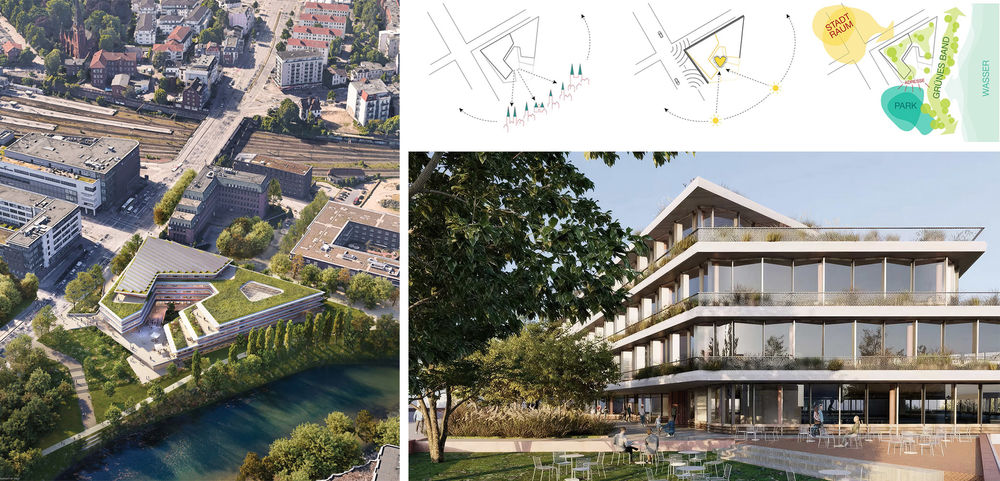
_________ 思考与展望 Reflections & Perspectives
Q: 工作室创立至今,有哪些有意思的瞬间可以分享给大家?团队的成长过程中,有哪些经历最令您和成员们难忘? Since the inception of the studio, could you share some interesting moments with us? Throughout the team’s growth, which experiences are the most memorable for you and the members?
刘涵晓:我觉得是我们这种能够一直保持生命力的整体氛围。在一个小集体里面,我能感觉到每个人的重要性,每一天都有挑战。所有的项目都是用提意见的方法去推进的,大家像朋友一样在一起工作,并且我们的工作方法是不重复的,甚至有时候会去研究怎么做一些比较夸张的事情。这是我觉得最有意思的一点,也是在别的集体不太容易去做的事情。
Luis Ricardo:我希望我们的合作伙伴都能够拥有如此快乐且有趣的思维。我们的想法有的时候可能会很幼稚,像在“幼儿园里的成年人”,但这些想法的积累是必不可少的,因为在这其中可能会生成一些有意义的话题(以便从问题中真正汲取出一点东西来)。我们会在周五下午下班前举行一些聚会活动,比如观影会或讲座,也会邀请一些好友来共同参与到一些话题的讨论中。这些话题不一定限定在建筑领域,相反我们希望可以吸收更多不同的东西,而不是将思维局限在理性的一边,让规则和代码充斥着我们的大脑。
Liu Hanxiao: I believe it’s the dynamic overall atmosphere that keeps us vibrant. Within our small collective, the importance of each team member is palpable, and each day presents new challenges. Our projects advance through a collaborative exchange of ideas, akin to friends working together. Our working methods are non-repetitive, and sometimes we even delve into researching how to do some more extravagant things. That’s what I find most interesting.
Luis Ricardo: I hope that our collaborator is thinking really happy and playful. What we thought sometimes looks like a grown up at kindergarten, but we need this time to gather ideas to actually emulate a little bit from problems. We make some kind of gathering in the end of a Friday afternoon, like a movie section or a conference that we invite some friends to talk about some topic. it’s even better when these topics are out of the architectural field so that we could absorb more different things rather than stay on the rational side whereas rules and code filled up our mind.
▼上海U479 – 插件式布展零售艺术体验,Shanghai U479 – Curated Plug.in Experiences
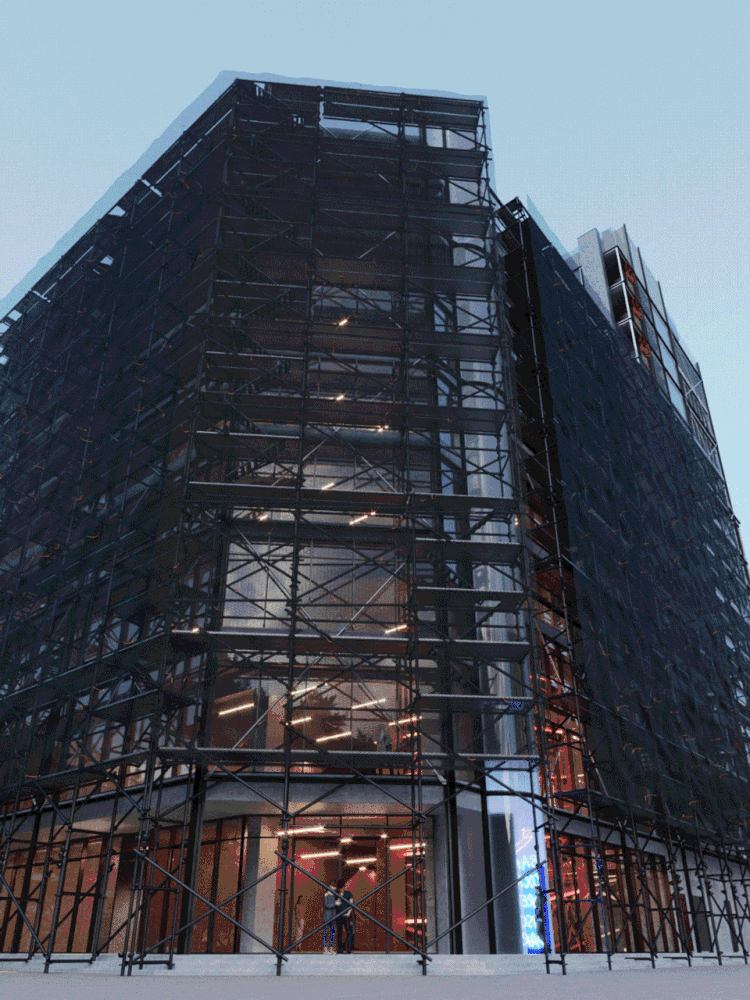
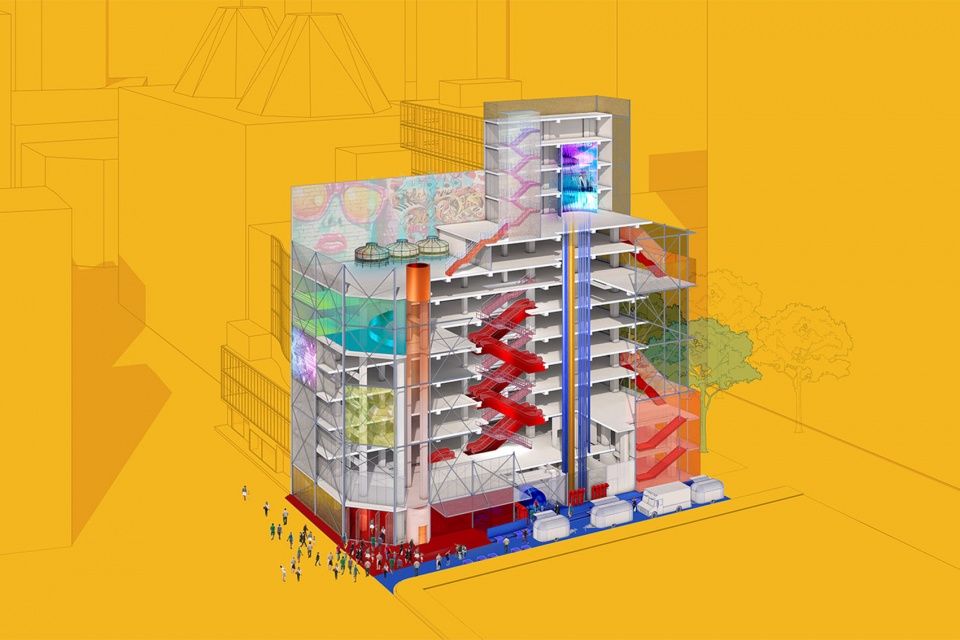
▼EARTH #9,地球九号能量重置 – 数据冷链中心会客厅,EARTH #9 – Internet Data Center and Cold Chain Logistics as City Living Rooms

Q: 工作室目前有哪些正在进行当中的项目?有哪些领域是团队希望在未来进行实验和挑战的? What projects are currently in progress, and are there specific areas the team aims to experiment with and challenge in the future?
刘涵晓:首先我们想做的事情就是尝试保持我们做事方法的平衡,可能不会像以前那样,一直采取的是比较“自我”的做事方法,而是要变得更加“准确”,更加明确每个部分能够推进到什么程度。但我们不会给自己太大的压力,把每件事情认真地做完,我相信未来就会取得不错的成果和发展。我们目前的项目所涉及的范围从乡村逐渐扩展到范围更广的城市,甚至是公益性的内容,所以很多事情的实现难度要远大于从前。如何整合更多的规划和资源,如何与不同的实践团队沟通,同时保持新鲜且多样的设计语言,这是我们当下面临的新挑战。
Luis Ricardo:我们目前还尚未考虑过接手高层建筑的项目,因为我们现在已经身处于高楼林立的钢铁森林之中了。但是,当我们身处在这样的环境中时,有时候也会有想要挑战去做一个塔楼的想法,这很神奇,就好像你自身被这种环境所吸收了一样。所以,我们最好不要做过多的预设。比如,如果我在看一场足球比赛,我也会产生想要设计一个体育场的想法,如果这个想法真的迎来了实现的一天,那么我们就需要去研究它是如何运作的,只有研究透彻了才能产生出更好的设计与结果。
▼llLab.部分概念性项目模型,Part of the conceptual projects model of llLab.
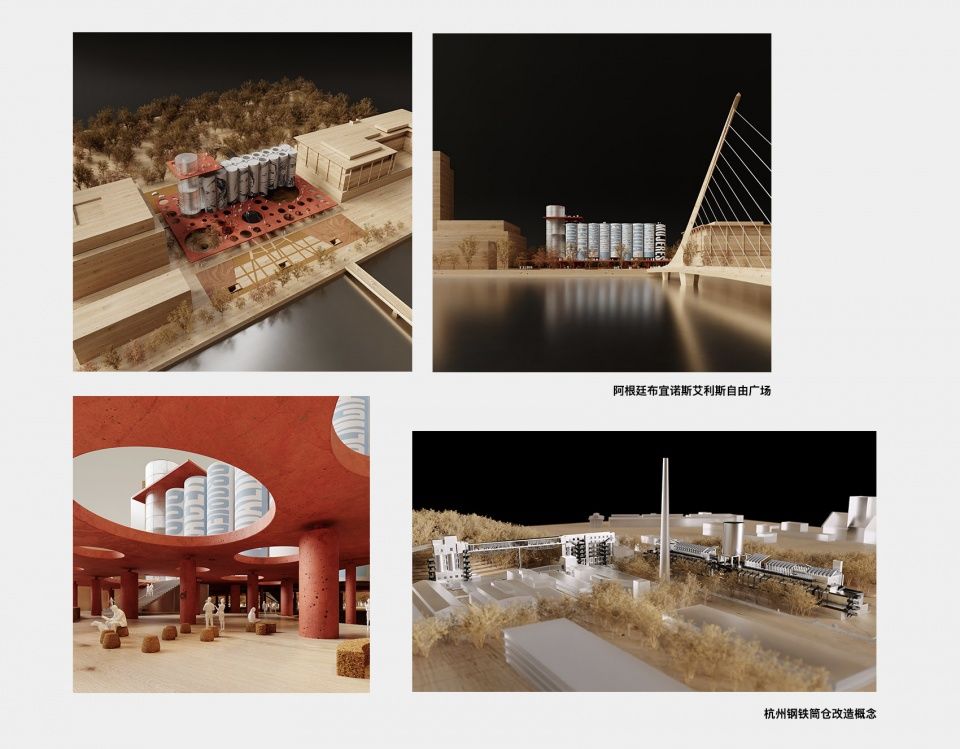
Liu Hanxiao: Initially, our focus is on attempting to strike a balance in our working methods, aiming for greater precision and clarity regarding the progression of each aspect. However, we won’t burden ourselves with excessive pressure to meticulously complete every task. I am confident that, with time, we will achieve favorable results and development. Our current projects span from rural to more extensive urban areas, and even include philanthropic initiatives. As a result, the difficulty of realizing many tasks has increased significantly. The current challenges we are facing involve how to integrate more planning and resources, communicate effectively with diverse practice teams, meanwhile maintaining a fresh and diverse design language.
Luis Ricardo: We never thought building a high-rise tower because you are in the middle of so much towers. But as you are in this moment there, you also want to do a tower, because you are like absorbed by these towers. This is the magical thing. So, it’s better to not have a specific need beforehand. If I’m in a football stadium watching a football game, probably I’d say one day I want to build a stadium, because we are searching on how it works, how could it be better.
▼llLab.部分正在进行中/概念性项目效果图,Renderings of the ongoing/conceptual projects of llLab.

Q: 您对于中国的建筑教育有什么看法? What do you think of architectural education in China?
刘涵晓:我觉得可能要稍微再“玩”得更多一点。做建筑还是需要用玩的心态去了解事情,再用更严肃的态度去做这件事情。感情是没有方法可以设计的,只有通过经历和体验,才能感受到真实的设计是什么样子。我觉得这个社会太急了,这也是我有意地去远离一些媒体或者活动的一个原因。我们每天接受到的信息太多了,这种信息的工业化会让人产生一种“我什么都知道”的错觉,所有的事情都会产生一种快速的对比,从而激发了急功近利的想法。但是当你远离这种状态,用一种更”慢“的态度去做事的时候,你会发现整个人都舒服了很多,同时你的设计也会变得更加有韧劲。我觉得应该给设计师更多一点时间,更重要的是树立长远的目标,创造更多让设计师和大众进行讨论的机会。
▼llLab.刘涵晓于活动与演讲现场,llLab. Liu Hanxiao at the event and speech
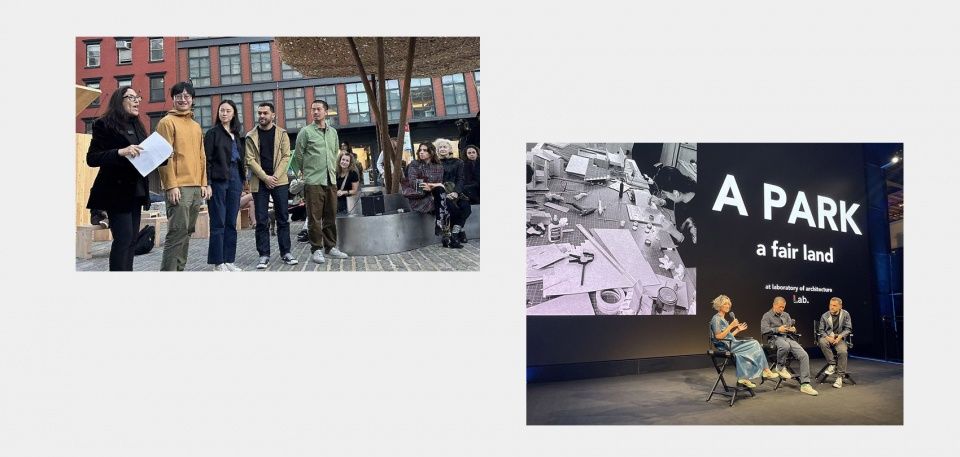
Liu Hanxiao: I believe there might be a need to inject a bit more playfulness. In the field of architecture, understanding things requires approaching them with a playful mindset before applying a more serious attitude to the task at hand. Emotions cannot be designed; they are only truly felt through experiences and exposure. I find our society to be overly fast-paced, which is one reason why I intentionally distance myself from certain media or events. However, adopting a slower approach brings about a more comfortable overall state, and your designs gain more resilience. Designers should be afforded more time, and, crucially, there should be a focus on setting long-term goals, creating additional opportunities for designers and the public to engage in meaningful discussions.
▼刘涵晓,Liu Hanxiao
出品人:向玲 / Producer: Xiang Ling 编辑:石安,武晨曦、亓慧 / Editor: Shi An, Wu Chenxi, Qihui
▼视频,Video (全文深度采访见下方文字。视频为4分钟精华版,建议选择1080p高清版本观看)
_________ 关于叙向llLab. About llLab.
Q: 四位创始人国籍不同,当初是在怎样的契机下成立llLab.的?事务所的创办初衷是什么样的?工作室名称 “llLab.”有何寓意? The four co-founders of llLab. have different nationalities. How did you initially come together to establish llLab.? What was the original intention behind founding the studio? What does the studio name “llLab.” symbolize?
刘涵晓:刚开始工作室只有我和Luis两个合伙人,我们是在斯图加特工作期间认识的,他是我觉得唯一能一起创建事务所的人,也是唯一答应我一起合作一个使事务所成立的那个项目的人,因此LLLab.最开始是源于我们名字里的两个L。后来加入了David Correa和Taichi Kuma,我们四个人合作的初衷可以说都不是关于自己,而是希望能够做一些贡献社会的事情。Lab可以体现一些建筑相关的内容,但又没有明确地指向某种明确的含义和态度,我觉得这有利于我们去拓展未来的平台,同时也不会限制我们给别人留下的印象。于此基础之上,我们又希望最小化我们自己的存在感,于是LLLab.转变为llLab.。最小化个体的存在,突出做事情的性质。
Luis Ricardo:我和涵晓在德国合作了几个项目,真正让我们开启合作的关键项目是古根汉姆博物馆竞赛。我们有很多共同之处,在性格和思维方式上都有某种共通。因此,我们相信我们的合作一定会非常有趣。太一和David都是斯图加特大学的校友,David还在那里获得了博士学位。在讨论项目时,我们会碰撞出非常有趣的火花,所以,我们觉得我们之间肯定能形成一种非常良好的合作关系。他们两位在团队中主要承担学术研究的部分。研究是我们非常热衷的事情之一,也是我们将事务所称为“Lab”的原因,我们想成为一个有想法的“实验室”,而不是专注于某一种风格或某一个人。
Liu Hanxiao: Initially, the studio consisted of only Luis and me as partners. We met in Stuttgart while working, and he was the only person I felt was capable of co-founding a firm with me and the only one who agreed to collaborate on the project that led to the establishment of the studio. Therefore, LLLab. originated from the two Ls in our names. Later, David Correa and Taichi Kuma joined us, and our collaboration was driven by a common goal of making a positive social contribution rather than personal aspirations. “Lab” reflects some architectural elements without explicitly pointing to a specific meaning or attitude. I believe this is benefit for us to expand our future platform without limiting the impressions we leave on others. Base on this, we also wanted to minimize our own presence, leading to the transformation of “LLLab.” into “llLab.”– a move aimed at reducing individual visibility and emphasizing the essence of our work.
Luis Ricardo: Hanxiao and I was collaborating in several projects in Germany, and the Guggenheim competition was the key project that made us work together really. There are a lot of things that we have in common, and some kind of influence like in terms of the personalities, and the way of thinking as well. So, we find a really interesting and playful collaboration.
Then, as we know, Taichi and David were graduated from the University of Stuttgart and David has got his PhD there. We have real interesting discussions about projects, and we thought that could be a really good partnership that they take more the research part of the office. This is what we like a lot in the office, and also why we call it actually lab, because we want to be a laboratory of ideas, not like focusing one style or focusing one person.
▼四位创始人,The four co-founders
Q: llLab.几位创始人的分工如何?除了建筑设计的部分,团队还进行哪些学术研究工作?不同办公室的工作环境和方法有何异同?平时的工作氛围是怎样的? What roles do you play within the team? In addition to architectural design, what other academic research activities does the team undertake? What are the similarities and differences in the working environment and methods among different offices? What is the daily working atmosphere like?
刘涵晓:主要的实用性的,或者说实践性的工作是我和Luis在做。我们目前的大部分项目在北京,这两年渐渐开始有其他国家的项目(葡萄牙,美国,德国)开始进行,但事务所大部分人员在上海,主要是觉得和我们以前的生活方式比较像,简单轻松。Luis从葡萄牙来中国的次数和时间变得越来越多,所以他会把我们在国内的实践变成一些更加国际性的拓展。David Correa一直在做关于材料和大自然的研究,之前的很多实践都与科学和材料以及一些非常微观的内容相关。最初我们的主旨是想找到一种试验性的使用材料的方法,与相对传统的建筑产生新的结合。这依然是一个很有难度的研究课题。
平时在工作室里,大家都可以随意地讨论,随时提出反对。我们的团队也始终保持着一种人人都有自主权去表达的氛围。我们是一个非常欢迎说话和创作的集体,也不会存在那种必须去实施的规定。每个人都有非常自由的创作权利,然后我们会找一个共同的方向把它们给融合起来。
Luis Ricardo:我们的目标实际上是“融合”,为其中融入多样性。这种多样性才是设计有力的原因。我们对每个项目都保持非常开放的态度,我们很自豪我们没有特定风格。涵晓会对我们的设计热情进行主要的把控,但是同时,我们也会将我们的多文化背景融入到设计之中,例如将中国以及地中海葡萄牙建筑文化和知识结合在一起,这在某种程度上仍然是我们设计的根源。
Liu Hanxiao: The primary practical, or rather, applied work is carried out by Luis and me. Currently, the majority of our projects are located in Beijing, with the inclusion of projects in other countries such as Portugal, the United States, and Germany over the past two years. However, the bulk of our team is in Shanghai, primarily because it aligns more closely with our previous lifestyle, emphasizing simplicity and ease. David Correa consistently focuses on research concerning materials and nature, with many of his past endeavors revolving around the intersection of science, materials, and intricate microscopic elements. Initially, our goal was to discover experimental approaches to using materials, fostering innovative blends with relatively conventional architecture. This remains a challenging subject of research. Our team consistently retains an atmosphere where everyone enjoys the right to express themselves. Each individual possesses the liberty to create, and subsequently, we collectively shape a shared direction to integrate these creative contributions.
Luis Ricardo: Our intention is actually to join together, join this diversity. We thought it was really powerful. We are really open to each project, and we are proud that we don’t have a style. Han xiao mostly is our passion for the design for sure. But also, however, a lot more cultural approach to bring up Chinese and more Mediterranean Portuguese architectural culture together and knowledge. It’s still the roots somehow in our designs.
▼llLab.上海办公室,Studio of llLab. in Shanghai
▼llLab.团队成员合照与漫画画像,Members of llLab. and caricatures of the team
_________ 野生集体主义设计 Wild Collectivist Design
Q: 什么是“野生集体主义设计”?能否解释一下这个词的含义?在设计时,会侧重于从哪些方面进行思考和研究? What is ‘Wild Collective Design’ ? During the design process, which aspects do you prioritize for contemplation and research?
刘涵晓:我本身不是完全在建筑体系里面发展的,所以很多时候不一定非要用教条或者传统体系的思维去理解建筑。很多事情可以通过不同的角度去思考,而不是非要先从过去提炼出某种经验才可以去做。可能是因为没有循规蹈矩的思维逻辑,所以导致有些设计变得有点“野”。也就是说慢慢的感觉到,我们的做事的方式可能并不是特别能够呼应行业内一些处理建筑的方法。“集体主义”说的是淡化个人,“我”并不重要。媒体的露出可能需要一个代表人,但如果这个人可以不是我,他不需要是我。我希望我们集体内的每个成员出去之后都能代表这个事务所,而不需要一定必须有某个人出现,才代表事务所在认真做事情。这是一个愿望。
从宏观城市的角度说,我始终觉得我们接到的项目本身和我们学到的东西差得很远。我们学到的都是有任务书的,但是这么多年我们基本没接过几份任务书,不仅是乡村的,也包括城市的,很多策划都需要我们自己来完成。我们的思维是通过判断和预测人群的发展方向去开始建筑设计,所以它不算是一种城市或者建筑规划,而是基于对人和经济或者文化方面的理解,去推算这个地方做什么事情、做到什么程度是最合适的。所以我们需要在宏观城市方面进行很大的投入,这种投入很可能无法体现在建筑的物理表现形式上,而是更多体现在建成和运营之后,是受其影响之后的城市群体产生的一种真正的变化。所以我觉得对于城市的学习和研究是比较“隐形“的,有点像在策划一种集体性的未来行为,带来了多种多样的可能性。
Liu Hanxiao: Many aspects can be approached from different views, and our unconventional thoughts lead to designs that may be a bit ‘wild.’ When we mention “collectivism,” we mean diminishing the importance of the individual, where ‘I’ is not a focal point. While the media may require a representative figure, it doesn’t necessarily have to be me; any member of our collective can effectively represent the firm.
Throughout the years, we’ve rarely taken on any formal design briefs, and our plans often necessitate independent execution. Our approach begins with predicting the population’s development direction to initiate architectural designs. This isn’t conventional urban or architectural planning; instead, it’s rooted in an understanding of people, economics, and culture, allowing us to determine the most suitable activities for a context and their extent. Substantial investment is thus required at the city’s macro level. This investment may not manifest physically in the architecture but rather in the genuine changes occurring within the urban community post-completion and operation. Studying and researching cities, in our perspective, are somewhat ‘invisible,’ resembling the planning of collective future behaviors that bring forth diverse possibilities.
▼llLab.部分代表作,Part of the projects by llLab.

